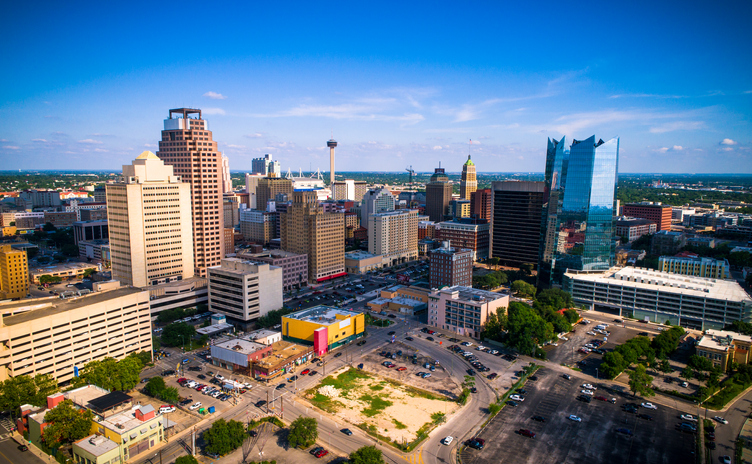San Antonio Road Safety Overview

San Antonio is the second most populous city in Texas, which — while an impressive fact — means the city experienced the second-highest number of motor vehicle crashes in Texas in 2021.
These sorts of traffic accidents cause a wide range of outcomes. Though most car accidents only cause damage to property, many accidents produce visible injuries that require medical attention.
San Antonio Car Accident Statistics
According to the Texas Department of Transportation (TxDOT), San Antonio reported a total of 38,461 traffic accidents throughout 2021.
Running a query through TxDOT’s Crash Records Information System (CRIS) will reveal that the collective total of 2021’s accidents consisted of the following:
- 294 bicycle accidents
- 647 pedestrian accidents
- 32,750 multi-vehicle collisions
The remaining crashes were single-vehicle accidents in which a vehicle ran off the road, hit a fixed object, or overturned.
Also, according to CRIS, multi-vehicle collisions in San Antonio in 2021 comprised the following:
- Four taxi accidents
- 294 motorcycle accidents
- 296 bus accidents
- 1,287 commercial truck accidents
In total, 95,509 people were involved in traffic accidents in 2021, including pedestrians, cyclists, and motorists.
These may seem like big numbers, but San Antonio’s population currently sits at nearly 1.5 million people. With that said, it’s important to understand how San Antonio’s statistics compare to the state of Texas as a whole.
Nearly 5% of Texas residents live in San Antonio. But in 2021, the city accounted for about 9% of Texas’s traffic accidents, meaning the city experienced car crashes 1.8 times more than it should have had based on its population share. In other words, drivers in the city were nearly two times more likely to get into a crash than drivers elsewhere in the state.
Crash Outcomes in San Antonio
Crashes in San Antonio included 11,109 non-fatal accidents and 171 that resulted in one or more fatalities.
In total, these crashes were the cause of:
- 182 fatalities
- 539 serious injuries in which the victim required an ambulance
- 4,307 minor injuries in which the victim was left with a visible wound but did not require an ambulance
- 6,263 possible injuries that caused symptoms, such as pain or dizziness, but did not leave a visible wound
Just over 70% of traffic accident victims suffered no injuries in their crashes. However, overall, these numbers are somewhat deceptive, as vulnerable road users, like pedestrians and cyclists, have a much higher risk of injury or death.
In fact, according to CRIS, San Antonio reported 941 crashes involving vulnerable road users in 2021, which were the cause of 67 deaths and 773 non-fatal injuries. Only 101 pedestrians and cyclists escaped injury in these instances, which means only 10.7% of vulnerable road users walked away from their crashes unscathed.
Dangerous Times to Travel in San Antonio
Generally, monthly traffic crash volumes in San Antonio increased throughout 2021 until they peaked in September, followed by a drop through the end of the year. As such, the most dangerous month of the year to drive was September, while the safest was February.
However, because February is so much shorter than other months, that previous statement is slightly misleading. If you take the length of the month into account, a pattern emerges in which crashes drop during the winter, rise through the spring and summer, and peak in the fall.
More specifically, weekdays have been found to be much more dangerous for driving as opposed to weekends. According to CRIS, the average weekday saw about 21% more crashes take place in contrast to the average weekend day. The most dangerous day to drive in San Antonio was Friday, and the safest was Sunday.
Even down to the hours of the day, crashes followed a predictable pattern, peaking during the morning commute (between 7 and 9 a.m.), dropping through the late morning, rising again through the early afternoon, and then peaking once more for the early evening (4 to 6 p.m.) commute.
Common Causes of Crashes in San Antonio
Crash causes vary depending on the location of the crash. According to CRIS, intersection crashes in San Antonio typically happen due to reasons such as running red lights and stop signs, as well as failing to yield the right of way.
The latter occurs when a driver does any of the following:
- Goes out of turn at a four-way or two-way stop
- Turns before oncoming traffic clears
- Proceeds through an occupied crosswalk
Intersection crashes can produce serious injuries, particularly when one vehicle hits the other’s door. The door can collapse inward, crushing the occupant.
Road crashes typically take the form of either a rear-end collision or a sideswipe, and they occur due to different causes than intersection crashes, such as speeding, tailgating, and distracted driving. They are more likely to injure the head and spine due to the whiplash motion they cause.
Crash Hotspots in San Antonio
Crashes happen all across San Antonio, but certain intersections and roads are much more dangerous than others.
Some of the most dangerous roads and highways in San Antonio include the following:
- I-35/US-87
- Culebra Rd.
- Military Dr.
- I-410/TX-16
- Bandera Rd./Spur-421
- I-10/US-87
These roads suffer from persistent traffic congestion that involves far too many cars in much too little space. As a result, a moment’s distraction or carelessness can lead to a collision.
Alongside its major roadways, San Antonio also has several dangerous intersections, which are as follows:
- Commerce St. and Zarzamora St.
- Buena Vista St. and Zarzamora St.
- McCullough Ave. at the I-35 ramps
- Culebra Rd. and Bandera Rd.
Intersections become so treacherous for many reasons, including poor traffic control signs or signals and inadequate pedestrian and bicyclist protection.
Driving Safely in San Antonio, TX
Drivers on San Antonio’s roads have a much higher risk of crashing than in other Texas cities, a risk that comes from the traffic congestion you will likely find as you commute through the city.
Nevertheless, you can safely navigate San Antonio’s roads and highways with a few precautions under your belt. Avoid traveling during the afternoon rush hour, and try to take less crowded roads.
Too many cars in too little space increase the risk of a collision, but fortunately, San Antonio is large enough that you can often plan your route to avoid busy streets and highways.
